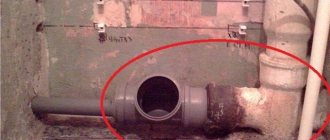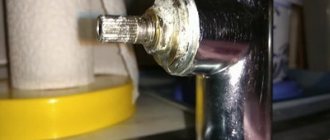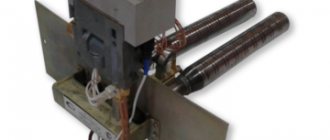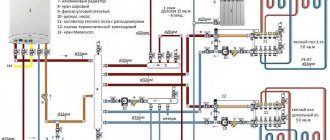Complex automation systems that perform the role of switching operating modes of certain devices are built on the simplest elements. They tend to change any of their parameters (shape, volume, electrical conductivity, etc.) under the influence of one or more factors.
Thus, all modern heating elements are equipped with thermostats that control the degree of surface heating. The basis of any thermostat is a bimetallic plate.
What is a bimetallic plate
An element that has the property of deforming (bending) in one direction under the influence of elevated temperature is called a bimetallic plate. From the name you can guess that the plate contains two metals. Each of them has its own coefficient of thermal expansion. As a result, when such a plate is heated, one component expands by a certain amount, and the second by another.
This leads to a bend, the shape of which depends on the difference in temperature coefficients. The rate of deformation is directly proportional to the change in temperature. When the plate cools, it returns to its original position. The plate is a monolithic compound and can work indefinitely.
Price range
The cost of the Zhukovsky AOGV 23 boiler depends on the specific model and ranges from 20-24.4 thousand rubles. This price does not include the chimney. When purchasing, you should immediately clarify the equipment of the unit so that you do not have to urgently look for the necessary components.
In addition, additional costs will arise for concluding a warranty agreement.
It is not recommended to neglect this action, since subsequently you can spend a much higher amount on repairs.
NOTE!
Many users rely on their own skills and knowledge, intending to repair the boiler themselves. It must be remembered that unauthorized actions with gas equipment may entail administrative liability.
How does a bimetallic strip work?
The bimetal plate works as part of various thermal regulation and thermal control systems, or rather in thermal relays of many modifications. The simplest thermal relay includes:
- Heat-resistant housing. It contains all the relay elements.
- Terminals – used to connect an electrical circuit.
- Mechanical switches of contacts or contact groups. They make and open electrical contacts, turning a circuit on or off.
- Dielectric rod or gasket. Transmits mechanical force from the plate to the switch.
- Bimetallic plate. It is an element that responds to temperature changes and creates pressure on the rod.
- Temperature sensor. An ordinary metal plate directly connected to the control element. It has good thermal conductivity and transfers heat to the bimetal.
When the surface of the heater has an acceptable temperature, the bimetallic plate is in a certain curved (flat) state, the electrical contacts are closed, and current flows in the heater circuit.
As the surface temperature increases, the bimetal begins to heat up and gradually deforms, putting pressure on the rod. In this case, a moment comes when the rod opens the contact of the mechanical switch, and the current in the heater circuit is interrupted. Then it cools down, the plate cools down, the circuit closes, and everything repeats again.
Often relays are produced with the ability to regulate operation based on temperature.
Boiler bimetallic plate
Natural gas heating systems are high-risk devices and therefore include various condition monitoring sensors. So, the main safety element is the traction sensor. It determines the correct direction of exit of combustion products, that is, from the combustion chamber towards the chimney. This prevents carbon monoxide from entering the room and poisoning people.
The main component of the draft sensor is a bimetallic plate for a gas boiler. Its operating principle is similar to any bimetal, and the dimensions and parameters of the material are calculated in such a way that exceeding the temperature of 75 degrees in the channel leads to deformation of the plate and operation of the gas valve.
Specifications
Let's look at the technical characteristics of the Zhukovsky AOGV 23 boiler:
| Options | Values | ||
| AOGV 23-2 Economy | AOGV 23-2 Universal | AOGV 23-2 Comfort | |
| Boiler type | Gas heating | ||
| Fuel type | Natural gas with the possibility of conversion to liquefied gas | ||
| Functions | Heating (coolant supply to the radiator system) | ||
| Efficiency | 89 % | ||
| Boiler power (max) | 23 kW | ||
| Gas consumption | 2.55 m3/h | ||
| Heated area | Up to 200 m2 | ||
| Coolant temperature | 50°-90° | ||
| Power supply | Absent | ||
| Boiler weight | 52 kg | ||
What devices use bimetal?
The scope of application of the bimetallic strip is extremely wide. Almost all devices where temperature control is necessary are equipped with bimetal-based thermostats. This is explained by the design simplicity and reliability of such relay systems. In our usual technology, thermostats are:
- In household heating appliances: stoves, ironing systems, boilers, electric kettles, etc.
- Heating systems: electric convectors, gas and solid fuel boilers with electronics.
- In electric packages there is automatic shutdown.
- In electronics in measuring instruments, as well as in pulse generators and time relays.
- In thermal engines.
In industrial technology, bimetallic plates are installed in thermal relays designed to protect powerful electrical devices from temperature overloads: transformers, electric motors, pumps, etc.
User manual
In order not to lose the warranty for the maintenance of your unit in any case, you do not need to carry out work on installing the boiler and repairing it yourself. Connecting the product, its proper configuration, and the first start-up must be carried out by service specialists. They will make a separate entry about the work performed in the passport of the unit you purchased. It is necessary to carry out preventative maintenance of the entire boiler once a year - this is also noted in the technical data sheet of the device. Failure to maintain such records may void your warranty.
The Conord burner may sometimes not ignite. This may happen because:
- There is a lot of dirt on the burner. Before turning on the structure, you need to clean the nozzles with a soft brush or just a vacuum cleaner.
- There may not be enough oxygen to start the burner quickly. Again, it is necessary to clean the nozzles that supply air, thoroughly ventilate the room, and try to light the burner again.
- Perhaps the contacts in the thermostat have simply oxidized. This is where the cleanup takes place.
- Automation sensors are broken.
- It is necessary to blow out the igniter or clean it of any existing dust or dirt.
If your coolant cools down very quickly, you just need to switch the thermostat to maximum settings or increase the supply of fuel to the burner, if only the device instructions allow this kind of action.
In the summer, you will need to turn off the heating circuit altogether. You just need to turn off the tap at the coolant inlet. If the burner works alone, the water will heat up to 60 degrees in 1 hour. If the heated liquid is not all removed at once, it will retain heat for about another 2 hours.
Domestic has already earned an excellent reputation in the domestic heating equipment market thanks to the production of high-quality equipment. Among users, Conord units, reviews of which have mostly positive features, are always in fairly high demand.
When the device gets seriously hot, and there is no need for a large flow of water, it is simply turned off so that the water in the device does not boil.
To learn how Conord gas boilers are produced, see the following video.
When to change the plate
All bimetallic strips have a long service life, but sometimes replacement is inevitable. The need arises when:
- The bimetal has lost its properties or their properties have changed, which does not correspond to the operating mode of the device.
- The plate is burnt out (refers to thermal relays).
- If the fixing bolt is broken or the pilot burner fails (in gas boilers).
- When plate replacement is included in scheduled maintenance activities.
In household appliances it is usually not changed. If the thermoregulation system fails, the bimetallic plate is replaced with a whole unit, which are supplied as spare parts for a specific device model. But often the cause of thermostat failure is the burning of the opening contacts, and not the bimetallic plate.
Complex automation systems that perform the role of switching operating modes of certain devices are built on the simplest elements. They tend to change any of their parameters (shape, volume, electrical conductivity, etc.) under the influence of one or more factors.
Thus, all modern heating elements are equipped with thermostats that control the degree of surface heating. The basis of any thermostat is a bimetallic plate.
Advantages and disadvantages
The positive features of gas appliances from Conord can be determined according to the reviews of those owners who actively use them:
- large model range;
- models have 3 types of automation;
- efficiency;
- high efficiency;
- in the event of a boiler breakdown, you can find spare parts quite quickly;
- good thermal insulation;
- guarantee of flawless operation for 3 years;
- uninterrupted operation for almost 15 years;
- steel heat exchangers help withstand thermal deformations;
- the use of water from the water supply system as a coolant;
- the ability to connect to a system with various types of circulation of the working environment;
- almost complete absence of wall-mounted appliances;
- energy independence of devices;
- use in certain series of automation parts made in Italy and Poland;
- simplified process of using the device.
Boilers from this manufacturer are created in accordance with the characteristics of the domestic climate and are designed to generate the required amount of heat to warm the home even in the most severe frosts.
The reliability of these popular devices is guaranteed by the increased level of durability of heating devices, and their independence from electricity will allow them to function without any failures or delays, especially in conditions where there is no electricity.
The low level of noise impact during operation, compact size and stylish design will allow you to place the device in the kitchen or any other room without harming the design of this room.
An efficiency of 90% makes Conord units the most popular in terms of savings. Thermal insulation materials greatly reduce heat loss.
A gas unit with 2 circuits from Conord can heat the room as quickly as possible, and also provide home owners with heated water for personal needs.
The safe operation of the products is guaranteed by the arrangement of various protection components of the automation box, which will help turn off the product when the traction is lost. In addition, the boiler will be turned off in the event of any breakdown or any other type of failure. You will be able to automatically adjust the heating temperature of the device, and if the fuel pressure level is too low, the device will provide rapid forced air injection to maintain the functionality of the device.
Disadvantages of Conord products:
- not the highest build quality of some models;
- the steel thickness will be no more than 3 mm;
- ban on the use of antifreeze.
The presence of special module burners will provide a significant reduction in fuel consumption. These innovations will help you achieve increased thermal efficiency while reducing fuel consumption, which will allow you to save on fuel.
What is a bimetallic plate
An element that has the property of deforming (bending) in one direction under the influence of elevated temperature is called a bimetallic plate. From the name you can guess that the plate contains two metals. Each of them has its own coefficient of thermal expansion. As a result, when such a plate is heated, one component expands by a certain amount, and the second by another.
This leads to a bend, the shape of which depends on the difference in temperature coefficients. The rate of deformation is directly proportional to the change in temperature. When the plate cools, it returns to its original position. The plate is a monolithic compound and can work indefinitely.
How does a bimetallic strip work?
The bimetal plate works as part of various thermal regulation and thermal control systems, or rather in thermal relays of many modifications. The simplest thermal relay includes:
- Heat-resistant housing. It contains all the relay elements.
- Terminals – used to connect an electrical circuit.
- Mechanical switches of contacts or contact groups. They make and open electrical contacts, turning a circuit on or off.
- Dielectric rod or gasket. Transmits mechanical force from the plate to the switch.
- Bimetallic plate. It is an element that responds to temperature changes and creates pressure on the rod.
- Temperature sensor. An ordinary metal plate directly connected to the control element. It has good thermal conductivity and transfers heat to the bimetal.
When the surface of the heater has an acceptable temperature, the bimetallic plate is in a certain curved (flat) state, the electrical contacts are closed, and current flows in the heater circuit.
As the surface temperature increases, the bimetal begins to heat up and gradually deforms, putting pressure on the rod. In this case, a moment comes when the rod opens the contact of the mechanical switch, and the current in the heater circuit is interrupted. Then it cools down, the plate cools down, the circuit closes, and everything repeats again.
Often relays are produced with the ability to regulate operation based on temperature.
Boiler bimetallic plate
Natural gas heating systems are high-risk devices and therefore include various condition monitoring sensors. So, the main safety element is the traction sensor. It determines the correct direction of exit of combustion products, that is, from the combustion chamber towards the chimney. This prevents carbon monoxide from entering the room and poisoning people.
The main component of the draft sensor is a bimetallic plate for a gas boiler. Its operating principle is similar to any bimetal, and the dimensions and parameters of the material are calculated in such a way that exceeding the temperature of 75 degrees in the channel leads to deformation of the plate and operation of the gas valve.
Varieties
There are three modifications of Zhukovsky AOGV 23 boilers:
- Economy _ Floor-standing unit with Russian automation, tubular heat exchanger. There is a temperature sensor.
- Station wagon. Italian SIT automatic equipment, modulated burner, coolant overheating sensor are installed.
- Comfort. In addition to all the options of the Universal models, the boilers have the possibility of remote control, a room thermostat, and protection against exceeding the coolant temperature.
Boilers of the Comfort modification can be distinguished from other varieties in appearance - they have a rectangular cross-section of the body, while Economy and Universal are round.
What devices use bimetal?
The scope of application of the bimetallic strip is extremely wide. Almost all devices where temperature control is necessary are equipped with bimetal-based thermostats. This is explained by the design simplicity and reliability of such relay systems. In our usual technology, thermostats are:
- In household heating appliances: stoves, ironing systems, boilers, electric kettles, etc.
- Heating systems: electric convectors, gas and solid fuel boilers with electronics.
- In electric packages there is automatic shutdown.
- In electronics in measuring instruments, as well as in pulse generators and time relays.
- In thermal engines.
In industrial technology, bimetallic plates are installed in thermal relays designed to protect powerful electrical devices from temperature overloads: transformers, electric motors, pumps, etc.
Peculiarities
To make sure that this product is of the best quality, you can read the various reviews about these products that users leave about them. Consumers are drawn to the fact that heating devices from Conord have a long service life, a decent degree of reliability and excellent efficiency. All factory products come with an extended warranty; for this reason, if anything breaks in the first 3 years of using the device, the manufacturer will provide free maintenance or high-quality repairs. The full period of such a guarantee is 15 years.
Externally, these units are distinguished by a rather strict design. Models with two circuits can be used in hot water systems during the warm season of the year and will not be dependent on heating. Gas products from Conord are launched using piezo ignition, and the technical characteristics reflect their excellent functionality.
All devices from Conord are divided into:
- Models where there is no system for supplying the consumer with heated water. They have built-in Italian automation and are extremely in demand.
- Heating devices that can only give warmth to your home. Their automatic elements use the principle of thermohydraulics.
- Boilers that not only provide home heating, but also heat water for domestic needs. They have built-in automation from Italy from SIT.
- Models that are capable of heating rooms and calmly warming liquid for various purposes. Thermohydraulic automation makes these tasks more simplified.
Construction of a gas boiler AOGV - 17.3-3
Its main elements are shown in Fig. 2 . The numbers in the figure indicate: 1 - draft breaker; 2 - traction sensor; 3 - draft sensor wire; 4 - start button; 5 - door; 6 - gas magnetic valve; 7 - adjusting nut; 8 - tap; 9 - reservoir; 10 - burner; 11 - thermocouple; 12 - igniter; 13 - thermostat; 14 - base; 15 - water supply pipe; 16 - heat exchanger; 17 - turbulator; 18 - bellows unit; 19 - water drainage pipe; 20 - traction breaker door; 21 - thermometer; 22 - filter; 23 - cap.
The boiler is made in the form of a cylindrical tank. On the front side there are controls that are covered with a protective cover. Gas valve 6 (Fig. 2) consists of an electromagnet and a valve. The valve is used to control the gas supply to the igniter and burner. In the event of an emergency, the valve automatically turns off the gas. Draft interrupter 1 is used to automatically maintain the vacuum value in the boiler furnace when measuring the draft in the chimney. For its normal operation, door 20 must rotate freely on its axis without jamming. Thermostat 13 is designed to maintain a constant temperature of water in the tank.
The automation device is shown in Fig. 3 . Let us dwell in more detail on the meaning of its elements. The gas, passing through the cleaning filter 2, 9 (Fig. 3), enters the electromagnetic gas valve 1 . Draft temperature sensors are connected to the valve using union nuts 3, 5 The igniter is ignited when the start button 4 . On the body of the thermostat 6 there is a setting scale 9 . Its divisions are graduated in degrees Celsius.
The desired water temperature in the boiler is set by the user using the adjusting nut 10 . Rotation of the nut leads to linear movement of bellows 11 and rod 7 . The thermostat consists of a bellows-thermal bulb assembly installed inside the tank, as well as a system of levers and valves located in the thermostat housing. When the water is heated to the temperature indicated on the dial, the thermostat is activated and the gas supply to the burner is stopped, while the igniter continues to operate. When the water in the boiler has cooled by 10 . 15 degrees, gas supply will resume. The burner lights up from the pilot flame. During operation of the boiler, it is strictly forbidden to regulate (reduce) the temperature using nut 10 - this can lead to breakage of the bellows. The temperature on the dial can be reduced only after the water in the tank has cooled to 30 degrees. It is prohibited to set the temperature on the sensor above 90 degrees - this will result in the automation device triggering and cutting off the gas supply. The appearance of the thermostat is shown in (Fig. 4) .
Floor steel models Conord
Let us immediately note that all boilers of this brand are produced in a floor-standing version. “Steel” boilers are those whose heat exchanger is made of steel. It is easy to find such a device in a catalog or price list by the marking, which begins with the letters “KS” (steel boiler).
For example, it is the steel heat exchanger that is installed in the boiler of the KSC-G-16 brand.
Here the letter “C” denotes the cylindrical shape of the heat exchanger, “G” is the type of fuel (gas), and the number “16” is the power in kilowatts.
The presence of the letter “B” in the marking (for example, KSC-GV-20) means that the boiler is 2-circuit.
Boilers with a steel heat exchanger are lighter and heat up quickly. However, they are less reliable and not as durable as cast iron. A significant disadvantage of steel is its susceptibility to corrosion.
How does the AOGV gas boiler turn on?
Actually, the procedure for turning on the device is quite simple, and besides, it is described in the operating instructions. And yet, let’s consider a similar operation with a few comments:
— open the gas supply valve (the valve handle should be directed along the pipe);
- press and hold the start button. In the lower part of the boiler, a hissing of escaping gas will be heard from the pilot nozzle. Then light the igniter and after 40.60 and release the button. A similar time delay is necessary to warm up the thermocouple. If the boiler has not been used for a long time, the pilot light should be lit 20...30 s after pressing the start button. During this time, the igniter will fill with gas, displacing the air.
Pre-launch activities
The location for the gas boiler is chosen depending on its modification
The position of the boiler is selected according to safety standards, away from fire hazards. The distance to wall structures is prescribed in the manufacturer's instructions. The body of the unit is set taking into account the horizontal and vertical levels, since if it is distorted, the work is disrupted.
The equipment is connected to the water supply and gas mains, ball valves and filters are installed using pipes. Before lighting the boiler, install the power supply and install a separate socket. First connect the chimney pipe and check for the presence of draft.
Possible malfunctions of the AOGV gas boiler
After releasing the start button, the igniter goes out. A similar defect is associated with a malfunction of the boiler automation system. Please note that operating the boiler with the automation switched off (for example, if the start button is forcibly jammed while pressed) is strictly prohibited. This can lead to tragic consequences, since if the gas supply is briefly interrupted or if the flame is extinguished by a strong air flow, gas will begin to flow into the room.
To understand the reasons for the occurrence of such a defect, let’s take a closer look at the operation of the automation system. In Fig. Figure 5 shows a simplified diagram of this system.
The circuit consists of an electromagnet, a valve, a draft sensor and a thermocouple. To turn on the igniter, press the start button. The rod connected to the button presses on the valve membrane, and gas begins to flow to the igniter. After this, the igniter is lit.
The pilot flame touches the body of the temperature sensor (thermocouple). After some time (30.40 s), the thermocouple heats up and an EMF appears at its terminals, which is sufficient to trigger the electromagnet. The latter, in turn, fixes the rod in the lower (as in Fig. 5) position. The start button can now be released.
The traction sensor consists of a bimetallic plate and a contact (Fig. 6). The sensor is located in the upper part of the boiler, near the pipe for exhausting combustion products into the atmosphere. If a pipe is clogged, its temperature rises sharply. The bimetallic plate heats up and breaks the voltage supply circuit to the electromagnet - the rod is no longer held by the electromagnet, the valve closes and the gas supply stops.
The location of the automation device elements is shown in Fig. 7. It shows that the electromagnet is covered with a protective cap. The wires from the sensors are located inside thin-walled tubes. The tubes are attached to the electromagnet using union nuts. The body terminals of the sensors are connected to the electromagnet through the housing of the tubes themselves.
Second group with a steel heat exchanger:
The Conord boiler with the design of a steel cylindrical heat exchanger made of cold-rolled metal is offered by the plant in single- and double-circuit versions. The service life is reduced compared to cast iron to 15 years. The designs use two automation options.
The first option: SIT automation from an Italian company known for its quality throughout the world. It is installed in the vast majority of all manufactured boilers in the European Union, such famous devices as: IMMERGAS, Fondital, Vaillant, Bosch and many others. The SIT valve allows you to guarantee a stable set temperature.
In addition, automation controls stable operation with a reduced gas pressure in the city pipeline. So the nominal value provides for operation with a pressure of 1.3 kPa, but a drop to 0.6 kPa is not a big problem and the Conord gas boiler continues to operate steadily, despite the fact that this is 46% less than required.
Single-circuit, with automatic SIT – heating only:
KSts-G-8S Heating capacity =8 kW KSts-G-10S Heating capacity =10 kW KSts-G-12S Heating capacity =12 kW KSts-G-16S Heating capacity =16 kW KSts-G-20S Heating capacity =20 kW KSts-G-25S Heating capacity =26 kW KSts-G-30S Heating capacity =30 kW KSts-G-40S Heating capacity =40 kW KSts-G-50S Heating capacity =50 kW
Single-circuit, with thermohydraulic automation
The second option is more budget-friendly, equipped with domestically developed AGU-T-M automatic equipment AGU is an automatic gas burner device, consisting of nozzles and safety automation. The main manufacturers are Mimax and Tagonrog. ASU automation consists of:
- temperature sensor;
- igniter with thermo-bimetallic plate;
- adjusting screw with lever;
- gas valve;
- block crane;
- connecting parts.
Ignition order:
- We check the draft, move the damper, light the igniter.
- Press the gas valve and light the wick. We fix and do not release the button until the bimetallic plate heats up.
- While continuing to hold the button, follow the lever. It will creep onto the inscription “ on the button ”, we need to wait for the moment when it is fixed.
- Release the gas valve and set the required temperature using the control knob.
Domestic automation makes it possible to buy a Conord boiler a little cheaper. In contrast to European analogues, it has the simplest design. It is non-volatile - no power supply is required. The starting process is carried out manually by igniting with matches or a lighter. By the way, thermo-hydraulic automation type AGU-T-M is widely used in Russian gas boilers
According to customer reviews, such automation is completely unpretentious, and the Conord floor-standing boiler equipped with it is not “capricious.” In addition, it is not difficult to find spare parts on the market even far from city centers. The prices are also not satisfactory, for example, one of the frequently requested parts - a bimetallic plate - is found everywhere for no more than 100 rubles.
KSts-G-10N Heating capacity =10 kW KSts-G-12N Heating capacity =12 kW KSts-G-20N Heating capacity =20 kW KSts-G-25N Heating capacity =25 kW KSts-G-30N Heating capacity =30 kW
Double-circuit with DHW and SIT automatic control system
The Conord floor-standing gas boiler, when equipped with two circuits, copes with the task of heating buildings and at the same time is capable of preparing hot water used for household needs. The design uses the proven modulation function. Burner operation using modulation significantly increases the efficiency of hot water supply.
KSts-GV-8S Heating capacity =8 kW KSts-GV-10S Heating capacity =10 kW KSts-GV-12S Heating capacity =12 kW KSts-GV-16S Heating capacity =16 kW KSts-GV-20S Heating capacity =20 kW KSts-GV-25S Heating capacity =25 kW KSts-GV-30S Heating capacity =30 kW
Double-circuit with DHW, with thermo-hydraulic automation
KSts-GV-12N Heating capacity =12 kW KSts-GV-20N Heating capacity =20 kW KSts-GV-25N Heating capacity =25 kW KSts-GV-30N Heating capacity =30 kW
Boiler Conord decoding
- K – boiler
- C – steel material for the heat exchanger
- C – cast iron, heat exchanger material
- G – gas
- B – DHW circuit
- C – cylindrical.
Let's consider the method for finding the above fault.
When repairing a gas boiler, testing begins with the “weakest link” of the automation device - the draft sensor. The sensor is not protected by a casing, so after 6.12 months of operation it becomes “overgrown” with a thick layer of dust. The bimetallic plate (see Fig. 6) quickly oxidizes, which leads to deterioration of contact.
The dust coat is removed with a soft brush. Then the plate is pulled away from the contact and cleaned with fine sandpaper. We should not forget that it is necessary to clean the contact itself. Good results are obtained by cleaning these elements with a special “Contact” spray. It contains substances that actively destroy the oxide film. After cleaning, apply a thin layer of liquid lubricant to the plate and contact.
The next step is to check the serviceability of the thermocouple. It operates in severe thermal conditions, since it is constantly in the flame of the igniter; naturally, its service life is significantly shorter than other elements of the boiler.
The main defect of a thermocouple is burnout (destruction) of its body. In this case, the transition resistance at the welding site (junction) increases sharply. As a result, the current in the Thermocouple - Electromagnet circuit.
The bimetallic plate will be lower than the nominal value, which leads to the fact that the electromagnet will no longer be able to fix the rod (Fig. 5) .
Floor cast iron models
A cast iron heat exchanger has almost twice the service life of a steel one (25 years versus 15) and is not afraid of corrosion.
So, if the floor structures can support its weight, this type of heat exchanger is preferable.
The buyer of a cast iron boiler should take into account an important point. Unlike steel, cast iron is brittle, so microcracks may appear in it during careless transportation.
If they are present, the service life of the heat exchanger will be significantly reduced. Also, due to its fragility, the product may burst if the temperature fluctuates sharply.











